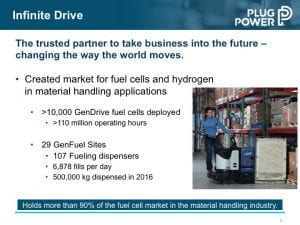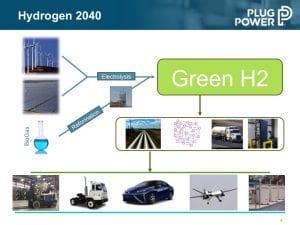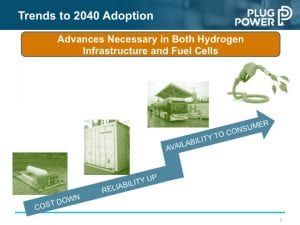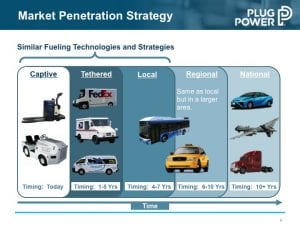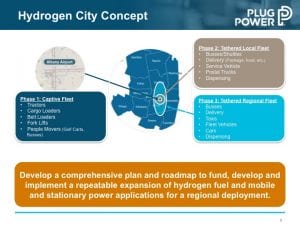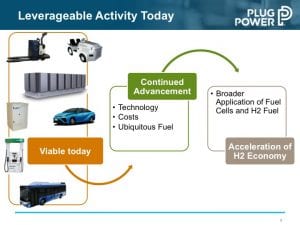“Happy Earth Day 2040” – Andy Marsh Looks at the Future of Hydrogen
By: Andy Marsh, CEO, Plug Power
Well we’re not quite to 2040 yet, but on Earth Day 2016, I visited Texas, a place I called home for twenty years, to drive home what it will take to make hydrogen fuel cells the leading power source over the next quarter of a century.
I spoke last Friday at the Hydrogen Energy in Texas Summit, held at the Embarcadero Building at Fair Park in Dallas, where other business, government and NGO energy stakeholders gathered to explore the future of hydrogen.
I took the opportunity to remind everyone that hydrogen and fuel cells present an opportunity to businesses to go green without breaking the bank. In fact, hydrogen and fuel cells are allowing major companies, some in Texas, the opportunity to increase their productivity and reduce operational costs, all while lowering their greenhouse gas emissions. Let’s take a look into my presentation to understand the big picture.
Infinite Drive
The foundation of my predictions for the future is based on the growth and success of Plug Power whose mission is to “change the way the world moves.” Plug Power has created a market for fuel cells in material handling applications where one did not previously exist. This first-mover advantage has allowed the company to garner:
- 90% of the material handling fuel cell market
- 10,000 GenDrive fuel cells deployed with 110 million operating hours
- 29 GenFuel sites with 107 fueling dispensers making 6,878 fills per day
Plug Power has a premier customer list including P&G, Walmart, Kroger, BMW and Home Depot, all using Plug Power products today and showing the viability of fuel cell technology.
2040 Vision
2040 will be the year that hydrogen fuel cells are the power source of choice for all kinds of devices. And while hydrogen fuel cells are a great solution, they are not going to make economic sense for every application. Lithium-ion batteries and future battery chemistries, along with new power generation, storage and fuel technologies may be good fits in some of these applications.
Plug Power’s success today in the fuel cell market sets the stage for where the industry is headed over the next quarter century, but there is much to be done to make the world a more innovative, efficient and environmentally conscious place by 2040.
Fuel / Technology and Availability
By 2040, I envision that advancements in renewable electricity and biogas will drive down costs allowing for competitive green hydrogen fuel. This can be done on-site or centrally with distribution to the site. The latter option will include using liquid hydrogen due to the density of the fuel, which can be better transported and require a much smaller footprint for future fueling stations. Today in Germany, companies are starting to bury liquid tanks, much like gas tanks are buried at stations today.
I believe that both CAPEX and OPEX cost reductions will be required, improved reliability to drive confidence and open markets and new technologies will need to be leveraged and created. But the industry won’t get there overnight – it has to have a plan to target the markets that are scalable in order to continue to make progress.
Captive Vehicles Help to Build out the Infrastructure
Thinking about success with captive vehicles like fork lifts, yard dogs, ground support equipment and people movers, I discussed how they leverage two things: they are electrified vehicles where economical fuel cell solutions can be “dropped in,” and they are captive fleets which simplifies fuel distribution greatly.
The next great market is one that shares some of these factors. For example, vehicles that are tethered and local, that is those that leave, but come home each day such as delivery trucks, shuttles, postal trucks, fleet cars. Over the next year to five years, this opportunity looks similar to that of the captive vehicles, but just in a slightly bigger area. The ratio of dispensers to deployed fuel cells will be very similar to the captive market.
Beyond that – in the next four to seven years hydrogen will make inroads into non-industrial local equipment, like buses, taxis, fleet cars and utility vehicles, which are similar to the hydrogen fuel solution used by captive and tethered vehicles, but need smaller, efficient distributed liquid hydrogen fuel assets. Regional and national vehicles, such as consumer, class 8, drones and autonomous vehicles, will come over time as we gain traction in the captive, tethered and local vehicles and as the network of hydrogen fuel improves.
Hydrogen City
To get to the hydrogen city concept that includes the captive, tethered and local and regional and national fleet above, we need to develop a comprehensive plan and roadmap to fund, develop and implement a repeatable expansion of hydrogen fuel and mobile and stationary power applications for a regional deployment. The catalyst to this development is affordable, reliable hydrogen.
Today, hydrogen costs nearly $4.00 per kilogram and the hope is that by 2040 the cost will be down to $2.40. This is not a “chicken or egg” scenario, but can be achieved with the thoughtful rollout and adoption of the technology in new applications.
During my presentation, I discussed how today, the industry has outgrown its early reputation of developing “science projects,” and now many see it as providing viable commercial products that provide real benefits to the customers for improved productivity and cost reduction, and in many cases also reduce GHG footprints. Accelerating sales of these commercial products allows hydrogen firms to push harder on research and development to advance the technology and reduce the costs around fuel cells and hydrogen, which then drives accelerated creation and adoption of new uses and applications of the technology – a beautiful, continuous cycle.
While Plug Power is the clear leader in fuel cell technology and products today, the company won’t be doing this alone. I have emphasized several times: a concerted, industry wide effort is necessary to collectively drive commercial applications so the industry can continue to see advancements in cost reduction, technology and infrastructure that all can leverage. Texas is already investing in public refueling dispensers, which is good, but only a start. The industry needs to build support, through additional commercial products and smart development plans, to continue this expansion for the future. Texas is also unique in its existing hydrogen pipeline infrastructure that can potentially be leveraged today and in the future.
Even with this exciting vision of the future, it’s important to remember that the market for hydrogen in distribution center and other captive markets is a very large market with a lot of growth to be had in the coming years. Plug Power will continue leading the way because it is important to the business and it is important to the nation’s future. To get to a hydrogen fuel cell future of 2040, it will take long-term vision, persistence, smart research, development and support from the industry.
I’m proud to see a place I called home for so many years among the leaders advancing the hydrogen and fuel cell industry. Everything’s bigger in Texas, including its Infinite Drive.
